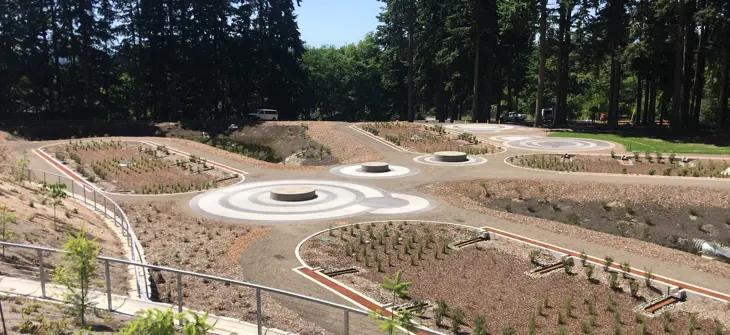
Stormwater Parks as Community Assets
How Stormwater Parks Enhance Urban Resilience and Community Well‑Being
Public parks benefit the community by providing places for recreation, gathering, education, and relaxation. Often, they provide benefits in the form of economic vitality and enhanced livability by driving tourism, improving our physical and mental health, and boosting neighborhood connectivity within the areas we live, work and play. Most everyone would agree that a public park's social, economic, physical and environmental health benefits are of great value to its community.
Public parks can provide greater environmental benefits if we examine them from a stormwater management context. Unrealized opportunities exist to include holistic water quality improvements in park projects. Stormwater parks are public facilities that enhance communities by providing stormwater treatment and recreational opportunities in the same location. They can improve local placemaking, manage regional-scale runoff, provide centralized stormwater management, and integrate landscaping with treatment to meet community-wide green infrastructure goals. Capitalizing on these public investment opportunities can further enhance the existing neighborhood fabric in certain redevelopment situations while accelerating placemaking in less developed or historically marginalized communities. Developing a stormwater park can effectively combine stormwater management and community livability when deployed appropriately.
Earlier in my career, I managed a municipal post-construction stormwater compliance program. I vividly remember many inter-agency conversations concerning ways to integrate stormwater management within the parks system. One conversation even led to the development of improvements within an existing downtown riverfront park that lacked proper stormwater management. Streetscape bioretention and permeable paver parking stalls were added to a historic cobblestone street. A regional bioretention basin was sized to accommodate both the needs of existing impervious cover and future infill development within the highly impervious urban watershed that drains to the practice. Educational signage was added to inform visitors how stormwater runoff is managed within the park. Walkways and landscaping complement the stormwater park's aesthetic. My prior experience with stormwater parks allows me to fully appreciate the value these integrated systems can bring to a community while recognizing that stormwater parks are not a solution that works everywhere, all the time. There are several critical reasons to consider stormwater parks when evaluating whether this solution is right for your community:
1) Utilizes a Regional Stormwater Management Tool
A stormwater park will likely involve a larger drainage area than a typical individual commercial development, as it would optimize treatment capacity and overall footprint for the greatest return on investment. This opportunity can allow for all-in-one retrofitting by providing treatment for an area greater than that would otherwise be treated in a single installation. These facilities can also incentivize redevelopment by managing stormwater for future nearby land uses. The maintenance of a regional stormwater park is likely to be the responsibility of a public owner, who can more effectively program annual funding into future budgeting cycles and often has the staff expertise to ensure ongoing performance meets initial expectations.
2) Improves Placemaking within Communities
Stormwater parks can transform underutilized, possibly forgotten parcels of land into neighborhood focal points. These facilities can minimize runoff from existing impervious areas, transform abandoned or excessive parking lots into green space, improve local biodiversity and water quality, and create a new, greener fabric for the surrounding community. These parks become living classrooms for students and adults alike. The improved aesthetic helps establish a place that nurtures the relationship between a community and the environment.
3) Accelerates Innovation and Acceptance through Demonstration
Stormwater parks allow the opportunity to use new technologies or techniques to enhance the local water quality compliance toolbox. Any innovative solutions within the park, along with their installation process and maintenance procedures, can be a model for the local development community if the project is successful. Signage can inform the citizenry regarding the importance of stormwater management, and school-age children can visit the facility as part of experiential learning opportunities. Local job training can be taught onsite for stormwater maintenance providers or municipal staff.
Stormwater parks should be viewed as community assets. These integrated systems not only treat polluted runoff from increased urbanization but also improve aesthetics, provide recreational and educational opportunities, and improve livability where they are constructed. As our communities become more urbanized, it's essential we begin evaluating community infrastructure beyond a singular purpose and utilize a holistic approach to urban design and stormwater management. While these two disciplines don't always see eye-to-eye, we should seek out opportunities to implement practices like stormwater parks that provide multiple social, environmental, and economic benefits within our local communities.
